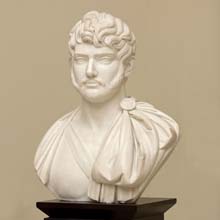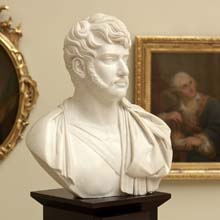

material: marble
dimensions: 60 x 52 x 30 cm
description: Prince Józef Poniatowski, a nephew of the last king of Poland, the commander in chief of the Duchy of Warsaw, was killed at the battle of Leipzig in 1813. Death in the waters of the Elster River was the beginning of his cult, strongly connected with the Napoleon’s legend. In 1817, his body was buried in St Leonard crypt in the Wawel cathedral. The bust is the sculptor’s copy of a study for the famous monument by Bertel Thorvaldsen in Warsaw. Jakub Tatarkiewicz, who together with Konstanty Hegel and Paweł Maliński studied under Thorvaldsen at the Academy of Saint Luke in Rome, successfully adopted the cold neoclassicism of his teacher in this work. Prince Józef Poniatowski was portrayed as a hero modelled on an ancient leader – with a Roman hairstyle and the naked torso. In order to emphasize the nationality of Prince Józef, a gown, asymmetrically draped on his arm, was fastened with a fibula featuring the eagle of the Duchy of Warsaw. The overwhelming influence of the ancient portrait sculpture is also manifested through some idealization of the facial features, yet preserving the characteristic elements of the sitter’s physiognomy. Agata Małodobry
exposition: The Gallery of 19th Century Polish Art in Sukiennice,
The Cloth Hall, 1, Main Market Square
key: Enlightenment >>>
dimensions: 60 x 52 x 30 cm
description: Prince Józef Poniatowski, a nephew of the last king of Poland, the commander in chief of the Duchy of Warsaw, was killed at the battle of Leipzig in 1813. Death in the waters of the Elster River was the beginning of his cult, strongly connected with the Napoleon’s legend. In 1817, his body was buried in St Leonard crypt in the Wawel cathedral. The bust is the sculptor’s copy of a study for the famous monument by Bertel Thorvaldsen in Warsaw. Jakub Tatarkiewicz, who together with Konstanty Hegel and Paweł Maliński studied under Thorvaldsen at the Academy of Saint Luke in Rome, successfully adopted the cold neoclassicism of his teacher in this work. Prince Józef Poniatowski was portrayed as a hero modelled on an ancient leader – with a Roman hairstyle and the naked torso. In order to emphasize the nationality of Prince Józef, a gown, asymmetrically draped on his arm, was fastened with a fibula featuring the eagle of the Duchy of Warsaw. The overwhelming influence of the ancient portrait sculpture is also manifested through some idealization of the facial features, yet preserving the characteristic elements of the sitter’s physiognomy. Agata Małodobry
exposition: The Gallery of 19th Century Polish Art in Sukiennice,
The Cloth Hall, 1, Main Market Square
key: Enlightenment >>>












